20th
Century and Beyond
Modern Rocketry
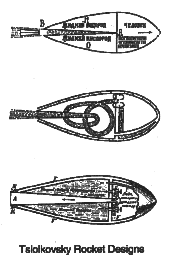 In
1898, a Russian schoolteacher, Konstantin Tsiolkovsky (1857-1935),
proposed the idea of space exploration by rocket. In 1903, Tsiolkovsky published
a report entitled Exploration of the Universe with Rocket Propelled
Vehicles. In it, he suggested the use of liquid propellants
for rockets in order to achieve greater range. Tsiolkovsky stated that the
speed and range of a rocket were limited only by the exhaust velocity of escaping
gases. For his ideas, careful research, and great vision, Tsiolkovsky has
been called the Father of Modern Astronautics.
In
1898, a Russian schoolteacher, Konstantin Tsiolkovsky (1857-1935),
proposed the idea of space exploration by rocket. In 1903, Tsiolkovsky published
a report entitled Exploration of the Universe with Rocket Propelled
Vehicles. In it, he suggested the use of liquid propellants
for rockets in order to achieve greater range. Tsiolkovsky stated that the
speed and range of a rocket were limited only by the exhaust velocity of escaping
gases. For his ideas, careful research, and great vision, Tsiolkovsky has
been called the Father of Modern Astronautics.
Early in the 20th century,
an American, Robert H. Goddard (1882-1945), conducted a variety
of practical experiments in rocketry. He was interested in a way of achieving
higher altitudes than were possible for lighter-than-air balloons. He published
a pamphlet in 1919 entitled A Method of Reaching Extreme Altitudes,
a mathematical analysis of what is today called the meteorological sounding
rocket.
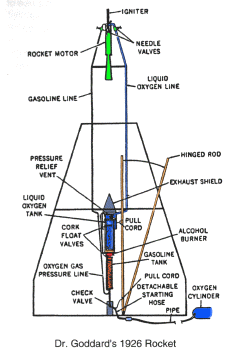 Goddard's
earliest experiments were with solid-propellant rockets. In 1915, he began to
try various types of solid fuels and to measure the exhaust velocities of the
burning gases. While working on solid-propellant rockets, Goddard became convinced
that rocket efficiency would be greatly improved by using liquid fuel. No one
had ever built a successful liquid-propellant rocket before. Doing so was much
more difficult than building solid-propellant rockets. Fuel and oxygen tanks,
turbines, and combustion chambers all would be needed.
Goddard's
earliest experiments were with solid-propellant rockets. In 1915, he began to
try various types of solid fuels and to measure the exhaust velocities of the
burning gases. While working on solid-propellant rockets, Goddard became convinced
that rocket efficiency would be greatly improved by using liquid fuel. No one
had ever built a successful liquid-propellant rocket before. Doing so was much
more difficult than building solid-propellant rockets. Fuel and oxygen tanks,
turbines, and combustion chambers all would be needed.
In spite of numerous difficulties,
Goddard achieved the first successful flight with a liquid-propellant
rocket on March 16, 1926. Fueled by liquid oxygen and gasoline, the rocket flew
for only two and a half seconds, climbed 12.5 meters, and landed 56 meters away
in a cabbage patch. By today's standards, the flight was unimpressive. But like
the first powered airplane flight by the Wright brothers in 1903, Goddard's
gasoline rocket was the forerunner of a whole new era in rocket flight. Goddard's
experiments in liquid-propellant rockets continued for many years. His rockets
became bigger and flew higher. He developed a gyroscope system for flight
control and a payload compartment for scientific instruments.
Parachute recovery systems were employed to return rockets
and instruments safely. Goddard, for his achievements, has been called the Father
of Modern Rocketry.
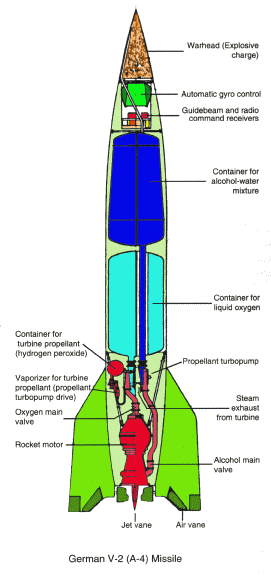 In
1923 a third great space pioneer, Hermann Oberth (1894-1989),
published a book entitled The Rocket into Interplanetary Space.
His book became the handbook for amateur rocketeers. Because of Oberth's work,
many small rocket societies sprang up around the world. In Germany, the formation
of one such society, the Verein fur Raumschiffahrt (Society
for Space Travel), led to the development of the V-2 rocket,
which was used against London during World War II. In 1937 Oberth and other
German engineers and scientists assembled in Peenemunde on the shores of the
Baltic Sea. There the most advanced rocket of its time was built and flown under
the direction of Wernher von Braun. For his achievements, Oberth
has been called the Father of Space Flight.
In
1923 a third great space pioneer, Hermann Oberth (1894-1989),
published a book entitled The Rocket into Interplanetary Space.
His book became the handbook for amateur rocketeers. Because of Oberth's work,
many small rocket societies sprang up around the world. In Germany, the formation
of one such society, the Verein fur Raumschiffahrt (Society
for Space Travel), led to the development of the V-2 rocket,
which was used against London during World War II. In 1937 Oberth and other
German engineers and scientists assembled in Peenemunde on the shores of the
Baltic Sea. There the most advanced rocket of its time was built and flown under
the direction of Wernher von Braun. For his achievements, Oberth
has been called the Father of Space Flight.
The V-2 rocket
(in Germany called the A-4) was small by comparison to today's rockets. It achieved
its great thrust by burning a mixture of liquid oxygen and alcohol and was able
to lob a one-ton warhead 50 miles high and hundreds of miles down range. The
rocket fuselage was made of thin, collapsible metal that was inflated with the
introduction of fuel into the tanks. Once launched, the V-2 was a formidable
weapon that could devastate entire city blocks.
Fortunately
for London and the Allied forces, the V-2 came too late in the War to change
its outcome. Nevertheless, by the War's end, German rocket scientists and engineers
had already laid plans for advanced missiles capable of spanning the Atlantic
Ocean and landing in the United States. These missiles would have had winged
upper stages but very small payload capacities.
With the fall
of Germany, many unused V-2 rockets and components were captured by the Allies.
Many German rocket scientists came to the United States, while others went to
the Soviet Union. The German scientists who came to the U.S., including Wernher
von Braun and Georg von Tiesenhausen, were amazed at the progress Goddard had
made.
Both the United
States and the Soviet Union realized the potential of the rocket as a military
weapon and began a variety of experimental programs. The U.S. site chosen by
von Braun and his colleagues, was Redstone Arsenal in Huntsville, Alabama, the
site at which NASA's Marshall Space Flight Center stands today. The United States
first began developing its space program with high-altitude atmospheric sounding
rockets, one of Goddard's early ideas. Later, a variety of medium- and long-range
intercontinental ballistic missiles were developed. These became the starting
point of the U.S. space program. Missiles such as the Redstone,
Atlas, and Titan would eventually launch astronauts
into space.
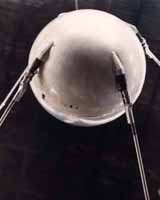 On
October 4, 1957, the world was stunned by the news of the world's first Earth-orbiting
artificial satellite launched by the Soviet Union. Called Sputnik I,
the satellite was about the size of a basketball, weighed about 183 pounds,
and had an orbital period of 98 minutes. It was the first successful entry in
a race for space between the two superpower nations. Less than a month later,
the Soviets followed with the launch of Sputnik 2 carrying a dog named Laika
on board. Laika survived in space for seven days before being put to sleep before
the oxygen supply ran out.
On
October 4, 1957, the world was stunned by the news of the world's first Earth-orbiting
artificial satellite launched by the Soviet Union. Called Sputnik I,
the satellite was about the size of a basketball, weighed about 183 pounds,
and had an orbital period of 98 minutes. It was the first successful entry in
a race for space between the two superpower nations. Less than a month later,
the Soviets followed with the launch of Sputnik 2 carrying a dog named Laika
on board. Laika survived in space for seven days before being put to sleep before
the oxygen supply ran out.
A few months
after the first Sputnik, the United States followed the Soviet Union with a
satellite of its own. Explorer I was launched by the U.S. Army
on January 31, 1958. In October of that year, the United States formally organized
its space program by creating the National Aeronautics and Space Administration
(NASA). NASA is a civilian agency with the goal of peaceful
exploration of space for the benefit of all humankind.
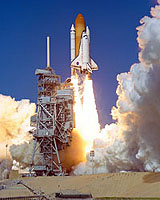 The
Soviet Union led the Space Race in the early days. But the U.S. persisted and
gradually captured the lead, culminating with its Apollo Program to the Moon,
which captured the imagination of the entire world. Who can forget John F. Kennedy's
daring pronouncement, "We will go to the Moon during this decade...not
because it is easy but because it is hard..." or Neil Armstrong's words
from the Moon's Tranquility Base, "That's one small step for man, one giant
leap for mankind."
The
Soviet Union led the Space Race in the early days. But the U.S. persisted and
gradually captured the lead, culminating with its Apollo Program to the Moon,
which captured the imagination of the entire world. Who can forget John F. Kennedy's
daring pronouncement, "We will go to the Moon during this decade...not
because it is easy but because it is hard..." or Neil Armstrong's words
from the Moon's Tranquility Base, "That's one small step for man, one giant
leap for mankind."
The Apollo
moon rocket is among the largest rockets ever designed to fly into space. Standing
as high as a skyscraper, the vehicle literally made the ground shake underfoot
when the engines were ignited for liftoff. And they lit the skies as Apollo
ascended from Cape Canaveral toward Earth orbit. America continued its flights
to the Moon throughout the decade of the 1970's, developing, with each new mission,
new confidence and new technology. Perhaps the most spectacular mission of all
was Apollo 13, always to be remembered for the outstanding courage and persistence
displayed by all involved in what could have been one of America's darkest hours.
Rockets have
been used to launch many post-Apollo piloted missions, including Skylab, and
the many STS missions. Rockets have also launched unpiloted military satellites,
communications' satellites, weather satellites, Earth observing satellites,
planetary spacecraft, planetary surface rovers, the Hubble Space Telescope,
and so on.
Since the earliest
days of discovery and experimentation, rockets have evolved from simple gunpowder
devices into gigantic vehicles capable of traveling into interplanetary space.
It might be interesting to hear the thoughts of those earliest rocket pioneers,
with their fire arrows and spinning spheres, if they could be brought through
time and shown where their discoveries have led.
Rockets
have certainly opened an important door to the universe.
Close
Window
 In
1898, a Russian schoolteacher, Konstantin Tsiolkovsky (1857-1935),
proposed the idea of space exploration by rocket. In 1903, Tsiolkovsky published
a report entitled Exploration of the Universe with Rocket Propelled
Vehicles. In it, he suggested the use of liquid propellants
for rockets in order to achieve greater range. Tsiolkovsky stated that the
speed and range of a rocket were limited only by the exhaust velocity of escaping
gases. For his ideas, careful research, and great vision, Tsiolkovsky has
been called the Father of Modern Astronautics.
In
1898, a Russian schoolteacher, Konstantin Tsiolkovsky (1857-1935),
proposed the idea of space exploration by rocket. In 1903, Tsiolkovsky published
a report entitled Exploration of the Universe with Rocket Propelled
Vehicles. In it, he suggested the use of liquid propellants
for rockets in order to achieve greater range. Tsiolkovsky stated that the
speed and range of a rocket were limited only by the exhaust velocity of escaping
gases. For his ideas, careful research, and great vision, Tsiolkovsky has
been called the Father of Modern Astronautics.  Goddard's
earliest experiments were with solid-propellant rockets. In 1915, he began to
try various types of solid fuels and to measure the exhaust velocities of the
burning gases. While working on solid-propellant rockets, Goddard became convinced
that rocket efficiency would be greatly improved by using liquid fuel. No one
had ever built a successful liquid-propellant rocket before. Doing so was much
more difficult than building solid-propellant rockets. Fuel and oxygen tanks,
turbines, and combustion chambers all would be needed.
Goddard's
earliest experiments were with solid-propellant rockets. In 1915, he began to
try various types of solid fuels and to measure the exhaust velocities of the
burning gases. While working on solid-propellant rockets, Goddard became convinced
that rocket efficiency would be greatly improved by using liquid fuel. No one
had ever built a successful liquid-propellant rocket before. Doing so was much
more difficult than building solid-propellant rockets. Fuel and oxygen tanks,
turbines, and combustion chambers all would be needed.  In
1923 a third great space pioneer, Hermann Oberth (1894-1989),
published a book entitled The Rocket into Interplanetary Space.
His book became the handbook for amateur rocketeers. Because of Oberth's work,
many small rocket societies sprang up around the world. In Germany, the formation
of one such society, the Verein fur Raumschiffahrt (Society
for Space Travel), led to the development of the V-2 rocket,
which was used against London during World War II. In 1937 Oberth and other
German engineers and scientists assembled in Peenemunde on the shores of the
Baltic Sea. There the most advanced rocket of its time was built and flown under
the direction of Wernher von Braun. For his achievements, Oberth
has been called the Father of Space Flight.
In
1923 a third great space pioneer, Hermann Oberth (1894-1989),
published a book entitled The Rocket into Interplanetary Space.
His book became the handbook for amateur rocketeers. Because of Oberth's work,
many small rocket societies sprang up around the world. In Germany, the formation
of one such society, the Verein fur Raumschiffahrt (Society
for Space Travel), led to the development of the V-2 rocket,
which was used against London during World War II. In 1937 Oberth and other
German engineers and scientists assembled in Peenemunde on the shores of the
Baltic Sea. There the most advanced rocket of its time was built and flown under
the direction of Wernher von Braun. For his achievements, Oberth
has been called the Father of Space Flight.
 On
October 4, 1957, the world was stunned by the news of the world's first Earth-orbiting
artificial satellite launched by the Soviet Union. Called Sputnik I,
the satellite was about the size of a basketball, weighed about 183 pounds,
and had an orbital period of 98 minutes. It was the first successful entry in
a race for space between the two superpower nations. Less than a month later,
the Soviets followed with the launch of Sputnik 2 carrying a dog named Laika
on board. Laika survived in space for seven days before being put to sleep before
the oxygen supply ran out.
On
October 4, 1957, the world was stunned by the news of the world's first Earth-orbiting
artificial satellite launched by the Soviet Union. Called Sputnik I,
the satellite was about the size of a basketball, weighed about 183 pounds,
and had an orbital period of 98 minutes. It was the first successful entry in
a race for space between the two superpower nations. Less than a month later,
the Soviets followed with the launch of Sputnik 2 carrying a dog named Laika
on board. Laika survived in space for seven days before being put to sleep before
the oxygen supply ran out.  The
Soviet Union led the Space Race in the early days. But the U.S. persisted and
gradually captured the lead, culminating with its Apollo Program to the Moon,
which captured the imagination of the entire world. Who can forget John F. Kennedy's
daring pronouncement, "We will go to the Moon during this decade...not
because it is easy but because it is hard..." or Neil Armstrong's words
from the Moon's Tranquility Base, "That's one small step for man, one giant
leap for mankind."
The
Soviet Union led the Space Race in the early days. But the U.S. persisted and
gradually captured the lead, culminating with its Apollo Program to the Moon,
which captured the imagination of the entire world. Who can forget John F. Kennedy's
daring pronouncement, "We will go to the Moon during this decade...not
because it is easy but because it is hard..." or Neil Armstrong's words
from the Moon's Tranquility Base, "That's one small step for man, one giant
leap for mankind."